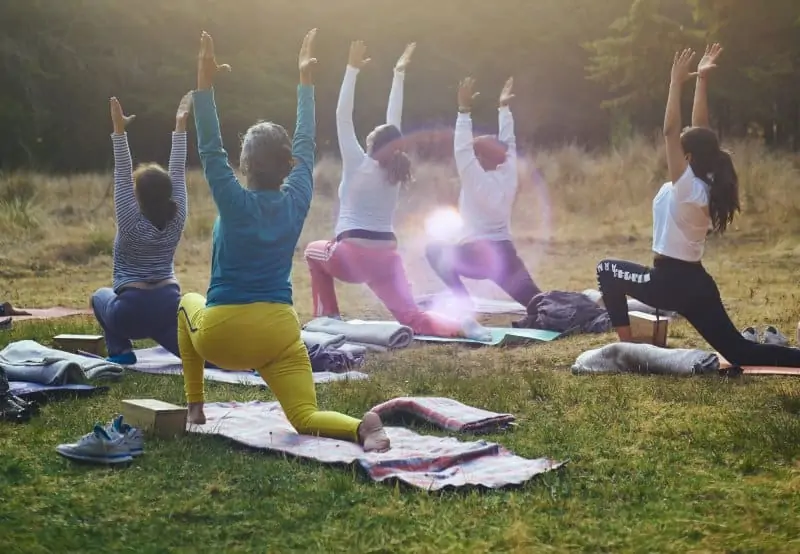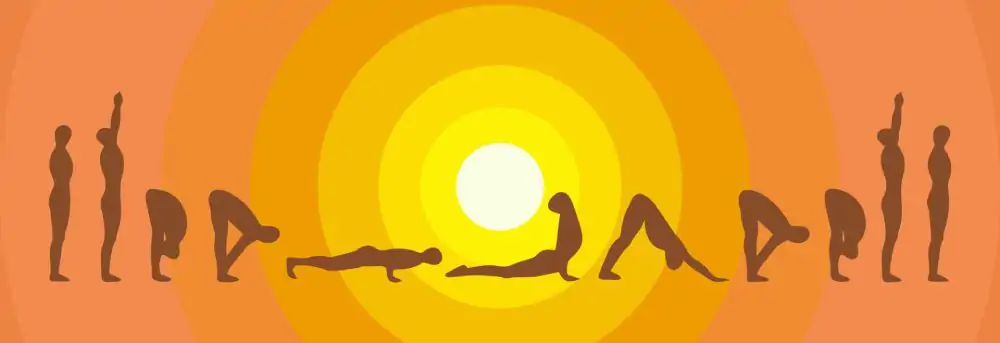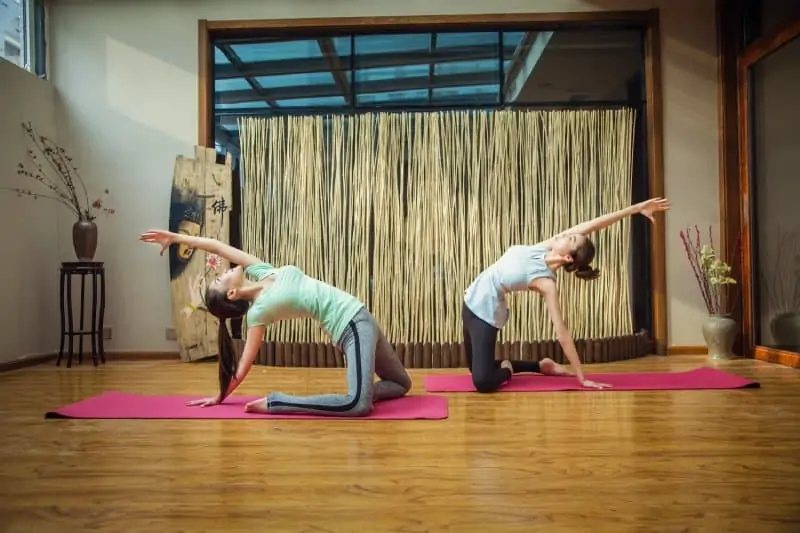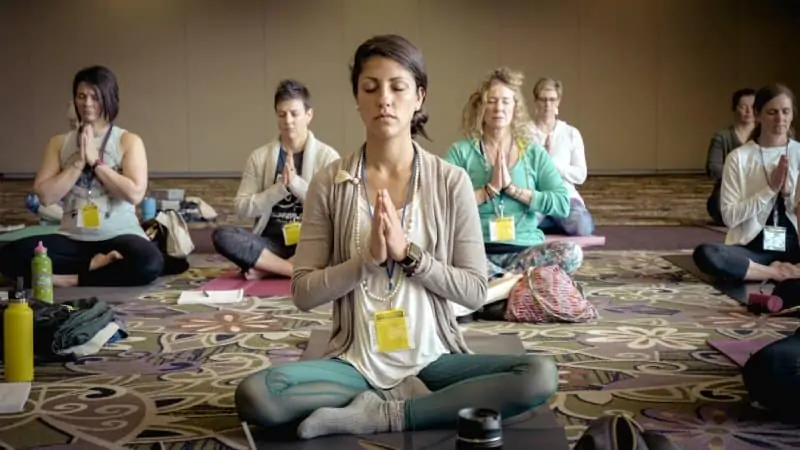“As you exhale, melt into your mat and release anything you’re holding onto, just let it out and feel yourself become lighter and freer,” the instructor said. I laid on my mat in savasana and closed my eyes, slowing my breath after my first ever yoga class. I was exhausted, but I followed her instructions and suddenly felt the hair standing up on my arms. Goosebumps formed on my skin as I felt the indescribable feeling of complete calmness, peacefulness, and bliss.
I was 16 at the time I discovered yoga. That first class literally transformed my reality. I felt clarity and focus unlike anything I’d ever experienced. Through years of practice, my body shifted into more balance and strength, and my mindset began to shift too. I discovered my path as a yogi and have since found deep purpose in helping other people become yogis too.
What is a Yogi?
A yogi is simply someone who practices yoga on a consistent basis; they have dedicated a significant part of their life to the yogic path. The feminine form of yogi is sometimes called a yogini. The word originates from the ancient holy language of India called Sanskrit.
Yoga translates to “to yoke” or “union”. Therefore, the definition of a yogi is a practitioner of yoga seeking to integrate mind, body, and spirit. It is relatively simple to become a yogi if you commit to mindfulness and a regular yoga practice.
Beyond the Physical
Typically, someone who dedicates themselves to a yogic path becomes a yogi for life by incorporating mindfulness, spirituality, and asana practice into their daily lifestyle. Beyond yoga postures themselves, a committed yogi uses pranayama (breath work), meditation, mudra (ritual hand gestures), karma yoga service, and ethical guidelines outlined in yogic philosophy.
The Yoga Sutras outline four levels of yogic practitioners. These levels are called ashramas, or levels of spiritual life. They include:
- Young student (brahmacharya): The beginner yogi focuses on physical training and mental discipline under the guide of a spiritual teacher such as guru or a yoga teacher.
- Householder (grihasta): Most modern yogis fall into this level by leading a “regular” life; working a job, maintaining positive relationships with friends and family, and living in an apartment or home.
- Hermit (vanaprasthya): This is a transitional stage where very dedicated yogis withdrawal from societal lives and lead a very quiet, minimalistic lifestyle with reduced ties to family and community.
- Renunciate (samnyasa): The final level of yogic path typically requires intensive practice, spiritual vows, and abandonment of physical attachments, much like a monk in pursuit of enlightenment or spiritual awakening (bodhi).
At its very core, becoming a yogi is about embodying humility, compassion, kindness, patience, and spiritual groundedness throughout all aspects of one’s life.
How to Become a Yogi
1.Learn Foundational Asanas

What we know as yoga in the western world is primarily focused on physical practice or asanas. An asana is a yoga pose that activates synchronization between breath, body, and mind.
Sun salutations are the most common and accessible sequence of yoga postures for beginners. They are often used as a warm up in the early morning while facing the sunrise. These poses slowly wake the body and prepare the muscles for deeper, more challenging asanas.
Scientifically, sun salutations target the solar plexus where our gut and core reside. They rev up the digestive and nervous system while improving mental wellbeing. A sun salutation is meant to flow from one posture to another, syncing the breath with movement.

A beginner sun salutation flow may include:
- Mountain pose (tadasana)
- Raised arm pose (urdhva hastasana)
- Forward fold (uttanasana)
- Flat back/half lift (arch uttanasana)
- Plank pose (kumbhakasana)
- Lower pushup (chaturanga dandasana)
- Cobra/up dog (bhujangasana)
- Downward dog (ado Mukha Svanasana)
- Forward fold (uttanasana)
- Return to mountain pose, and repeat
There are an abundance of books, posters, YouTube videos, and yoga classes to teach foundational asanas for any skill level. This is the first step to becoming a yogi or yogini.
2. Practice Mindfulness

The mental aspects of becoming a yogi are often more challenging than the physical. By practicing mindfulness in our daily lives, we become more in sync with our core spirit and less attached to fleeting feelings or emotions.
Mindfulness is simply the practice of being present and observing your thoughts, emotions, and circumstances through a lens of awareness and non-judgement. It is a form of meditation, but it doesn’t necessarily have to include sitting cross-legged and closing the eyes.
Mindfulness can be incorporated into walking, breathing, exercising, and visualizing. All you need to do is slow down, find presence, and observe your thoughts without interpretation.
A simple “body scan” mindfulness practice:
- Lay on your back and close your eyes
- Take a few deep breaths, focusing on the feeling of air entering and leaving the lungs
- Beginning at the very tip of the head, slowly do a mental “scan” of each part of your body, observing how it feels in your forehead, nose, eyes, chin, etc. until you reach the tips of your toes
- Move slowly, and if your mind drifts, bring it back to the breath
- When completing the scan, notice the emotions or sensations that you feel
- Journal about the random thoughts or memories that come up during this process
- Slowly stand up and return to your daily activities with a keen awareness of your body and mind
3. Read Books about Yogic Spirituality & Practice
Learning is at the core of becoming a yogi. A true yogi never stops learning and studying. Because many of us don’t have access to great “gurus” or renowned yoga teachers, we can instead delve into yogic practice through books. Reading a book is itself an act of mindfulness that allows for deep focus and relaxation, especially after a challenging asana practice or a long day at work.
Here are a few of my favorite books about yogic philosophy:
- Yoga Sutras of Patanjali
- Yoga Anatomy by Leslie Kaminoff and Amy Matthews
- The Practice of Mindful Yoga by Hannah Moss
- Embrace Yoga’s Roots: Courageous Ways to Deepen Your Yoga Practice by Susanna Barkataki
4. Make Yoga a Routine

As mentioned above, to progress in your path as a yogi you need to make yoga a part of your daily lifestyle. Practicing yoga asanas 2-3 times a week is ideal for progression both physically and mentally, however everyone’s path is different. Many yogis may find that daily 20 minute sessions of meditation, pranayama, or asana practice are ideal for keeping them in a “yoga state of mind”. Others pay prefer longer 1-2 hour sessions a few times per week.
But remember that the work does not end on the mat. In fact, your yoga mat and postures are only the beginning. A yogi’s routine expands far beyond physical practice into their daily interactions with other people in their personal and professional lives.
To be a true yogi, you must embrace the principle of ahimsa, or non-harming. This means approaching all people and living things with compassion and love. Whether in an argument with your significant other or feeling frustration at a stranger in traffic, yogic breathing or mindfulness practices can be used as routines to draw you out of any negative or harmful states of mind.
5. Invest in a Yoga Room or Studio Membership

A personal yoga space or yoga studio membership is a symbol of your dedication to the yogi path. This requires both a monetary and time investment, however the investments of positive energy and attentiveness are really the most important details.
You can design a yoga room in your home as your own special sanctuary to dedicate to your practice. Simple details like calming colors, soothing scents, plants and terrariums, tapestries, or other yoga decorations can make a huge difference for designing a sacred, relaxing space to practice your yoga routine.
On the other hand, a studio membership offers a sense of community and escape from the stressors of your daily life. When you enter a studio and arrive at your mat, the outside world dissolves away and you don’t have the distractions of your home or office. Studios are especially valuable for beginner yogis because quality teachers will help you achieve better alignment, balance, form, and accountability in your practice.
6. Deepen Your Practice with Teacher Training

Yoga teacher training is what really took my yoga practice to the next level. It allows for deep immersion and focused study on individual principles, postures, and traditions. There are two types of teacher training: 200 hour and 300 hour trainings with various certificates recognized by organizations such as Yoga Alliance.
If you decide to take a teacher training, be sure that you have allotted enough time and space in your life for focused studies and practice. You can learn in a wide variety of “schools” of yoga, from vinyasa to ashtanga to yin yoga to hatha, and beyond.
Some yogis engage in teacher training simply to deepen their practice, without the intent of becoming teachers. Others find that the yogi path is their dharma (calling in life) and devote themselves to pursuing yoga as a long-term career and life path.
Either way, the value of yoga teacher training extends far beyond the professional or monetary outcomes it may provide. Teacher training reconnected me with my body and soul, while bringing me community of yogis that I remain close with decades later.
Conclusion
Ultimately, the path of the yogi is very personal and spiritual, but should never be taken alone. Anyone can become a yogi through dedicated practice, but not everyone who does yoga is necessarily a yogi. There are no official accreditation’s determining who is or is not a yogi; instead, the yogic path is a philosophy and way of life that calls certain people to delve deep into their spiritual core and become aware of the connectedness of all of the Universe.
I hope this was helpful and that you have fun discovering and playing on your new journey as a yogi. Until next time, Namaste!
FAQ
What is a yogi?
A yogi is a dedicated practitioner of yoga and yogic philosophy, including asanas (yoga postures), pranayama (breath work), meditation, mudras (ritual gestures), ahimsa (non-harming), and ancient ethics.
What is the definition of a yogi?
Yogi translates from Sanskrit to “one who practices yoga”.
How do you become a yogi?
Consistent dedicated practice of yoga, both on the mat and in daily life, will lead you on the path to becoming a yogi.
What does yogi mean?
At its core, a yogi is someone who has taken their yoga practice beyond the physical realm and stepped onto a dedicated path of spirituality, ethics, and yogic ritual.


